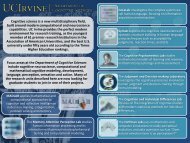Conscious Realism and the Mind-Body Problem - UCI Cognitive ...
Conscious Realism and the Mind-Body Problem - UCI Cognitive ...
Conscious Realism and the Mind-Body Problem - UCI Cognitive ...
Create successful ePaper yourself
Turn your PDF publications into a flip-book with our unique Google optimized e-Paper software.
<strong>Conscious</strong> <strong>Realism</strong> <strong>and</strong> <strong>the</strong> <strong>Mind</strong>-<strong>Body</strong> <strong>Problem</strong> 101an interface between us <strong>and</strong> <strong>the</strong> world, as in <strong>the</strong> old sense datum <strong>the</strong>ories.Instead, MUI <strong>the</strong>ory simply acknowledges that our sensory worlds of space<strong>and</strong> time, objects, motions, colors, sounds, touches, tastes, smells <strong>and</strong>pains are observer-dependent <strong>and</strong> are not likely, on evolutionary grounds,to resemble <strong>the</strong> objective world, whatever form that world might have.This point is simple, but can be counterintuitive since we habitually assume,from early childhood, that <strong>the</strong> objective world resembles our sensoryworlds.A seventh objection is that MUI <strong>the</strong>ory is logically faulty, because it issimply not true that real user interfaces do not imitate <strong>the</strong> physical world;on <strong>the</strong> contrary, <strong>the</strong>y do <strong>the</strong>ir best to reproduce a physical-like world.This objection is correct in noting that <strong>the</strong> user interface on a typicalcomputer employs icons that imitate shapes <strong>and</strong> colors familiar fromeveryday sensory perception. However, <strong>the</strong>se icons do not imitate <strong>the</strong>diodes, resistors, voltages <strong>and</strong> magnetic fields inside <strong>the</strong> computer that<strong>the</strong>y represent. The icons purposely hide all this complexity, so that computerusers can get on with <strong>the</strong>ir work.The idea that our sensory perceptions in everyday life are useful preciselybecause <strong>the</strong>y do not resemble what <strong>the</strong>y represent is, for most people,counterintuitive. Fortunately, <strong>the</strong> recent introduction <strong>and</strong> widespreadpopularity of user interfaces on personal computers gives a ready-to-h<strong>and</strong>metaphor that most can grasp: <strong>the</strong> typical computer user underst<strong>and</strong>sthat icons of <strong>the</strong> interface are useful precisely because <strong>the</strong>y simplify, <strong>and</strong>in no way resemble, <strong>the</strong> complex world of hardware <strong>and</strong> software <strong>the</strong>yrepresent.An eighth objection focuses on <strong>the</strong> notion of resemblance, as follows:MUI <strong>the</strong>ory recognizes that a virtual replica of <strong>the</strong> world must share somecausality with its target (a virtual tennis ball must behave causally like<strong>the</strong> real one, more or less). However MUI <strong>the</strong>ory does not see that this isa kind of isomorphism between <strong>the</strong> world <strong>and</strong> <strong>the</strong> user interface. It seemsto consider only pictorial isomorphisms as relevant. This is not <strong>the</strong> case.This objection is correct in noting that a tennis ball in a realisticvirtual-reality game behaves much like a normal tennis ball. But <strong>the</strong> pointof <strong>the</strong> virtual-reality example is not <strong>the</strong> relation between virtual tennisballs <strong>and</strong> normal tennis balls, but ra<strong>the</strong>r <strong>the</strong> relation between virtualtennis balls <strong>and</strong> supercomputers. The point is that <strong>the</strong> virtual tennisball in no way resembles, pictorially or o<strong>the</strong>rwise, <strong>the</strong> structural or causalproperties of <strong>the</strong> supercomputer that is running <strong>the</strong> virtual tennis game.Then, by analogy, <strong>the</strong> reader is invited to envision <strong>the</strong> possibility that anormal tennis ball might in no way resemble, pictorially or o<strong>the</strong>rwise, <strong>the</strong>structural or causal properties of whatever observer-independent entitiesit represents.So <strong>the</strong> analogy offered here is as follows: Virtual tennis ball is to supercomputeras normal tennis ball is to <strong>the</strong> observer-independent world. The







